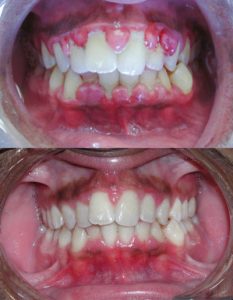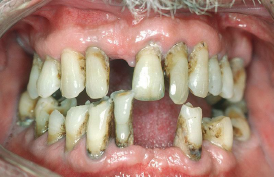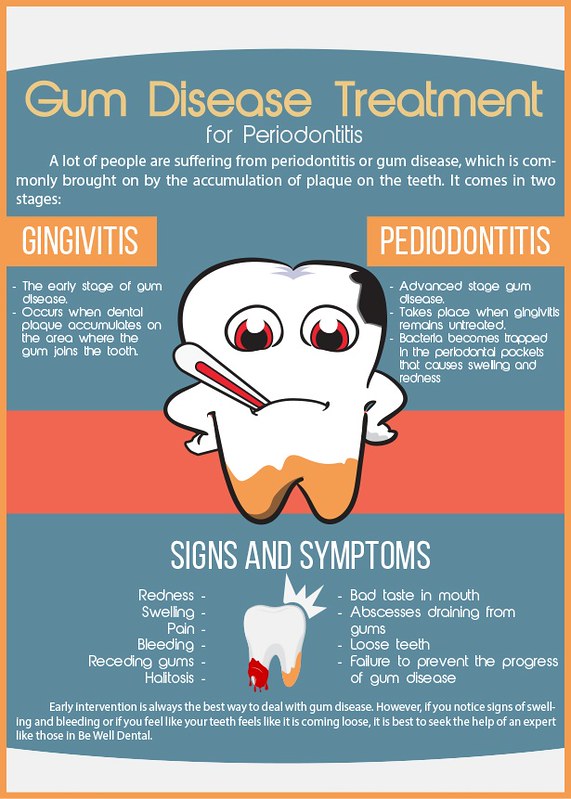CAN GUM RECESSION BE REVERSED ?
Gum recession CAN NOT be reversed, but it can get worse if it is not treated when it is present.
In order to understand why gum recession can not be reversed, it’s important to understand what the differences are between Gingivitis and Periodontal Gum disease.
Gingivitis is a reversible Gum infection.

There is no recession associated with
Gingivitis. There is only plaque and calculus
accumulation causing infection symptoms
such as redness and swelling of the gum
tissue.
Periodontal disease is an irreversible Gum
infection.

Under your gums, there is a bone ( called the alveolar process ), which is attached firmly to your tooth root by fibrous connective tissue ( called Periodontal Ligament).
Periodontal Disease is the breakdown of connective tissue attachment ( Periodontal Ligament ) between tooth and alveolar bone.
The Result is Recession, aka roots of teeth exposed.
This is caused by untreated Gingivitis.
 Source: https://www.flickr.com/photos/160995989@N02/44863978862. Everette Earls
Source: https://www.flickr.com/photos/160995989@N02/44863978862. Everette Earls
Causes and Symptoms of Receding Gums:
-
Swollen Gums
-
Family history
-
Bad Breath
-
Loose teeth
-
Teeth sensitivity to hot/cold
-
teeth shifting
-
poor brushing techniques – Brushing too hard, Brushing too many teeth at a time AKA scrubbing method of brushing,
-
Using a toothbrush with Medium/Hard bristles
-
Use of Frayed toothbrush
-
Grinding of your teeth causing abfraction
-
Poor-fitting Denture, partial
-
Hormonal Changes – pregnancy, puberty, menopause
-
Illnesses – Cancer, HIV, Diabetes. These illnesses weaken the body’s immune system and can cause inflammation throughout the body causing an easier chance of Periodontal Disease and Cavities.
-
Medications – Dilantin, Procardia, Adalat all have the ability to cause the gums to cause gum tissue to grow with bad oral hygiene
-
Increase in Periodontal Pocket Depths along with Calculus Formation under the gumline
HOW WILL GUM RECESSION AFFECT YOUR DENTAL VISIT?
Most people go to the dentist twice a year to get x-rays, to be checked for cavities, and to have their teeth cleaned. However, sometimes people need more than just a simple cleaning, such as root planing, because their gums are receding because their teeth are unhealthy.
A Prophylaxis is a preventative
treatment which helps to prevent
periodontal disease while root planing is
a procedure that is done after
periodontal disease is diagnosed.
CAN GUM RECESSION BE REVERSED?
Gum recession can’t be reversed, but it can get worse if it is not treated when it is present
When a patient needs periodontal maintenance, they should be informed about the differences in the type of treatment between prophylaxis and root planing, so they will understand how important periodontal maintenance is for the future health of their gums.
Prophylaxis is a preventative treatment administered to people who do not have periodontal disease. It is known as a regular “cleaning,” and it is three times cheaper than root planing. In the article “You Don’t Clean Teeth,” Carol Tekavec states that “….plaque, calculus, and stains are removed from the teeth.” Regular cleaning only deals with removing deposits from the teeth, rather than from the root. Many people get root planing confused with prophylaxis because they are both nonsurgical.
Prophylaxis is much different than a root planing because root planing deals with treating periodontal disease, whereas prophylaxis prevents it. Root Planing is a non-surgical periodontal procedure that removes bacteria from root surfaces. It is a necessary procedure when gum tissue is infected causing “inflammation of the gums. . . , bad breath, teeth shifting and may be implicated in several systemic conditions” (Tekavec). However, there is a significant price difference between prophylaxis and root planing.
GUM RECESSION TREATMENT VS REGULAR CLEANING
Once someone has periodontal disease, they will need ongoing care called periodontal maintenance. Root planing is one type of periodontal therapy that may be required. After someone has periodontal disease, they no longer need prophylactic treatment to prevent gum disease, because they already have it. Periodontal maintenance requires treatment four times a year, and sometimes surgery is required. Since root planing will be this patient’s new type of cleaning, the price of maintenance will be much more than someone that needs just a basic cleaning twice a year.
When a patient needs Periodontal maintenance, they should be informed about the differences in cost and treatment between prophylaxis and root planing, so they will understand their own dental care. A thorough understanding can help with periodontal maintenance after their first root planing. Prophylaxis is a preventative treatment that helps to prevent periodontal disease while root planing is a procedure that is done after the periodontal disease is diagnosed. Periodontal maintenance is very important, and people must be informed about why treatment is different and necessary for their general health. Since Periodontal disease can lead to other systemic diseases, it is very important that dental professionals let the client know their situation.
Tekavec, Carol. (2009, May 27). You Don’t Clean Teeth Modern Hygienist, pp. 1-3.
CAN GUM RECESSION BE REVERSED?
Gum recession CAN NOT be reversed, but it can get worse if it is not treated when it is present. In order to understand why gum recession can not be reversed, it's important to understand what the differences are between Gingivitis and Periodontal Gum disease.
Is Gingivitis Reversible?
Gingivitis is a reversible Gum infection. There is no recession associated with Gingivitis.
Is it possible to stop gum recession?
Root planing is one type of periodontal therapy that may be required to stop gums from receding any further. After someone has periodontal disease, they no longer need prophylactic treatment to prevent gum disease, because they already have it. Periodontal maintenance requires treatment four times a year, and sometimes surgery is required. Since root planing will be this patient's new type of cleaning, the price of maintenance will be much more than someone that needs just a basic cleaning twice a year.
Will my teeth fall out from receding gums?
Yes, eventually the attachment between the tooth and the bone will be destroyed to the point where they fall out. Under your gums, there is a bone ( called the alveolar process ), which is attached firmly to your tooth root by fibrous connective tissue ( called Periodontal Ligament). Periodontal Disease is the breakdown of connective tissue attachment ( Periodontal Ligament ) between tooth and alveolar bone.
Can gum grow back?
No, This is caused by untreated Gingivitis.
What's the best mouthwash for receding gums?
There is no Magic Mouthwash that will help with receding gums. Fixing the underlying issue which is brushing and flossing regularly along with going to your Dentist regularly is key to maintaining healthy teeth and gums. Most people go to the dentist twice a year to get x-rays, to be checked for cavities, and have their teeth cleaned. However, sometimes people need more than just a simple cleaning, such as root planing, because their gums are receeding because their teeth are unhealthy.
HOW WILL GUM RECESSION AFFECT YOUR DENTAL VISIT?
Most people go to the dentist twice a year to get x-rays, to be checked for cavities, and have their teeth cleaned. However, sometimes people need more than just a simple cleaning, such as root planing, because their gums are receeding because their teeth are unhealthy. A Prophylaxis is a preventative treatment which helps to prevent periodontal disease while root planing is a procedure that is done after periodontal disease is diagnosed.
What are the Causes and Symptoms of Receding Gums?
Swollen Gums Family history Bad Breath Loose teeth Teeth sensitivity to hot/cold teeth shifting poor brushing techniques - Brushing too hard, Brushing too many teeth at a time AKA scrubbing method of brushing, Using toothbrush with Medium/Hard bristles Use of Frayed toothbrush Grinding of your teeth causing abfraction Poor fitting Denture, partial Hormonal Changes - pregancy, puberty, menopause Illnesses - Cancer, HIV, Diabetes. These illnesses weaken the bodies immune system and can cause inflammation throughout the body causing an easier chance of Periodontal Disease and Cavities. Medications - Dilantin, Procardia, Adalat all have the ability to cause the gums to cause gum tissue to grow with bad oral hygiene Increase in Periodontal Pocket Depths along with Calculus Formation under the gumline
How is a regular cleaning different than a deep cleaning?
Prophylaxis is much different than a root planing because root planing deals with treating periodontal disease, whereas prophylaxis prevents it. Root Planing is a non-surgical periodontal procedure that removes bacteria from root surfaces. It is a necessary procedure when gum tissue is infected causing “inflammation of the gums. . . , bad breath, teeth shifting, and may be implicated in several systemic conditions” (Tekavec). However, there is a significant price difference between prophylaxis and root planing.
What is a Prophylaxis Dental Cleaning?
Prophylaxis is a preventative treatment administered to people who do not have periodontal disease. It is known as a regular “cleaning,” and it is three times cheaper than root planing. In the article “You Don't Clean Teeth,” Carol Tekavec states that “....plaque, calculus and stains are removed from the teeth.” A regular cleaning only deals with removing deposits from the teeth, rather than from the root. Many people get root planing confused with prophylaxis because they are both non surgical.
What is Periodontal Maintenance?
When a patient needs Periodontal maintenance, they should be informed about the differences in cost and treatment between prophylaxis and root planing, so they will understand their own dental care. A thorough understanding can help with periodontal maintenance after their first root planing. Prophylaxis is a preventative treatment which helps to prevent periodontal disease while root planing is a procedure that is done after periodontal disease is diagnosed. Periodontal maintenance is very important, and people must be informed about why treatment is different and necessary for their general health. Since Periodontal disease can lead to other systemic diseases, it is very important that dental professionals let the client know their situation.
Hi, your article is great and I want to share it in my instagram. But I think you can improve your current google ranks by using “seowebsitetraffic skyrank your website”. My sister uses it and it works great. Just google it, it’s a good service to bring you a lot of new engaging readers like me. Keep up the high quality work!
Thank you for your support!!
Dental Products Guy